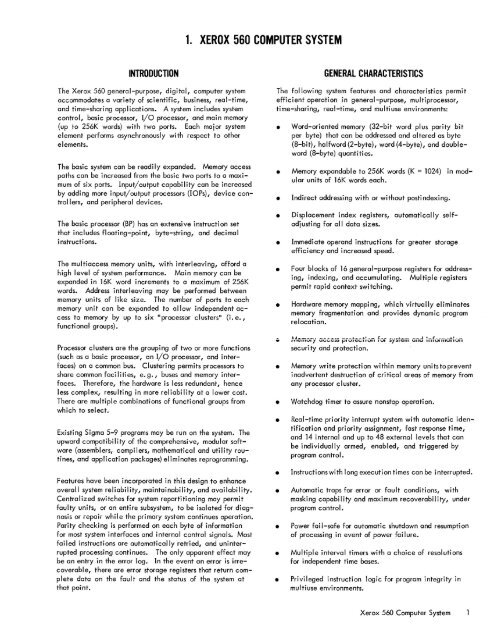1. xerox 560 computer system - The UK Mirror Service
1. xerox 560 computer system - The UK Mirror Service
1. xerox 560 computer system - The UK Mirror Service
Create successful ePaper yourself
Turn your PDF publications into a flip-book with our unique Google optimized e-Paper software.
<strong>1.</strong> XEROX <strong>560</strong> COMPUTER SYSTEMINTRODUCTION<strong>The</strong> Xerox <strong>560</strong> general-purpose, digital, <strong>computer</strong> <strong>system</strong>accommodates a variety of scientific, business, real-time,and ti me-shar i ng app I i cat ions. A <strong>system</strong> inc I udes <strong>system</strong>control, basic processor, I/O processor, and main memory(up to 256K words) with two ports. Each major <strong>system</strong>element performs asynchronously with respect to otherelements.<strong>The</strong> basic <strong>system</strong> can be readi Iy expanded. Memory accesspaths can be increased from the basic two ports to a maximumof six ports. Input/output capability can be increasedby adding more input/output processors (lOPs), device controllers,and peripheral devices.<strong>The</strong> basic processor (BP) has an extensi ve i nstructi on setthat includes floating-point, byte-string, and decimalinstruct ions.<strong>The</strong> multiaccess memory units, with interleaving, afford ahigh level of <strong>system</strong> performance. Main memory can beexpanded in 16K word increments to a maximum of 256Kwords. Address interleaving may be performed betweenmemory units of like size. <strong>The</strong> number of ports to eachmemory unit can be expanded to allow independent accessto memory by up to six II processor clusters" (i. e. ,functional groups).Processor clusters are the grouping of two or more functions(such as a basic processor, an I/O processor, and interfaces)on a common bus. Clustering permits processors toshare common faci I iti es, e. g., buses and memory interfaces.<strong>The</strong>refore, the hardware is I ess redundant, henceless complex, resulting in more reliability at a lower cost.<strong>The</strong>re are multiple combinations of functional groups fromwhich to select.Existing Sigma 5-9 programs may be run on the <strong>system</strong>. <strong>The</strong>upward compatibility of the comprehensive, modular software(assemblers, compi lers, mathematical and uti lity routines,and application packages) eliminates reprogramming.Features have been incorporated in this design to enhanceoverall <strong>system</strong> reliability, maintainability, and availability.Centralized switches for <strong>system</strong> repartitioning may permitfaulty units, or an entire sub<strong>system</strong>, to be isolated for diagnosisor repair while the primary <strong>system</strong> continues operation.Parity checking is performed on each byte of informationfor most <strong>system</strong> interfaces and internal control signals. Mostfai led instructions are automatically retried, and uninterruptedprocessing continues. <strong>The</strong> only apparent effect maybe an entry in the error log. In the event an error is irrecoverabl e, there are error storage reg i sters that return completedata on the fault and the status of the <strong>system</strong> atthat point.GENERAL CHARACTERISTICS<strong>The</strong> following <strong>system</strong> features and characteristics permitefficient operation in general-purpose, multiprocessor,time-sharing, real-time, and multiuse environments:• Word-oriented memory (32-bit word plus parity bitper byte) that can be addressed and altered as byte(8-bit), halfword (2-byte), word (4-byte), and doubleword(8-byte) quantities.•Memory expandable to 256K words (K = 1024) in modularunits of 16K words each.•••Immediate operand instructions for greater storageefficiency and increased speed.•Hardware memory mapping, which virtually eliminatesmemory fragmentation and provides dynamic programrelocation.•Memory write protection within memory units to preventinadvertent destruction of critical areas of memory fromany processor cluster.••Indirect addressing with or without postindexing.Displacement index registers, automatically selfadjustingfor all data sizes.•Four blocks of 16 general-purpose registers for addressing,indexing, and accumulating.permit rapid context switching.Multiple registersAA ____... ______ ___ J.. __ L~ __ L __ _ ~ ~_L ___ ___ .-.I ! __ r ______ L~___n .... II.v., ............"'= !-'.V."'.... IIVII 'VI ;'1;"""" ,",II,", II11V111,UIIUIIsecuri ty and protecti on.Watchdog timer to assure nonstop operation.Real-time priority interrupt <strong>system</strong> with automatic identificationand priority assignment, fast response time,and 14 internal and up to 48 external levels that canbe individually armed, enabled, and triggered byprogram control.• Instructions with long execution times can be interrupted.• Automatic traps for error or fault conditions, withmasking capability and maximum recoverability, underprogram control.• Power fail-safe for automatic shutdown and resumptionof processing in event of power fai lure.• Multiple interval timers with a choice of resolutionsfor independent ti me bases.• Privileged instruction logic for program integrity inmultiuse environments.Xerox <strong>560</strong> Computer System
















